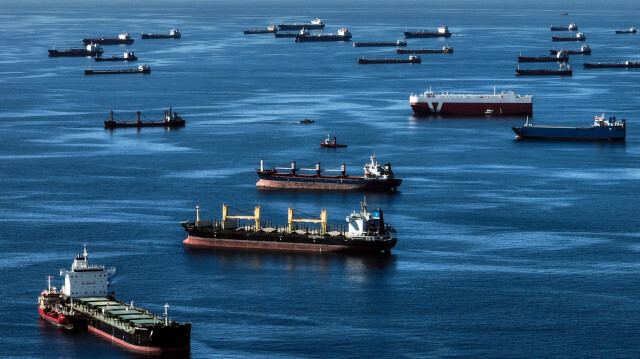
The number of vessels passing through the Suez Canal has fallen by 85% in the last six months due to ongoing political tensions while the number of vessels passing through the Cape of Good Hope has more than doubled, according to MarineTraffic data compiled by Anadolu.
Since Yemen's Houthis intensified their attacks on vessels in the Red Sea linked to Israel in response to its ongoing war on Gaza, especially since the end of last year, the region has been undergoing a change in maritime trade dynamics.
Most shipping companies using the Suez Canal -- the shortest maritime route between Asia and Europe which accounts for about 15% of the global maritime trade volume – have diverted to the longer route around South Africa's Cape of Good Hope.
"The alternative was to go around the Cape of Good Hope. A lot of shipping lines put an interim service to bridge the gap of what they thought would be a couple of months and this was only supposed to be a temporary solution," Tom Stainer, a sales manager at UK-based logistics company Westbound Logistics Services, told Anadolu.
The total number of commercial vessels including containerships and LNG, LPG, dry and wet bulk, roll-on/roll-off (ro-ro), and dry breakbulk carriers in the Suez Canal fell from 1,094 in November to 923 in December, when the Houthis began to intensify their attacks.
Vessel passages dropped to 233 in January, 94 in February and 85 in March. Last month, a total of 159 ships used the Suez Canal, marking a sharp decline of 85% in the traffic in the region, according to calculations by Anadolu based on MarineTraffic data.
The Suez Canal revenues have dropped by 50% amid growing tensions in the Red Sea, Egypt's planning minister said last month.
"The decline was caused by a disruption in shipping due to tensions in the Red Sea," Hala El-Saeed said on the sidelines of the World Economic Forum in Riyadh, Saudi Arabia.
- Cape of Good Hope traffic surges
Vessel traffic in the Bab el-Mandeb Strait also declined by 60.7% in the last few months. The strait saw the passage of 341 vessels in November, before dropping to 310 in December and 189 in January.
The number of vessels in the strait fell to 151 in February, 152 in March and 134 in April.
The data showed that ships passing through the Cape of Good Hope totaled 1,682 in November and 1,800 in December. However, this skyrocketed to 2,699 in January and 2,728 in February.
A total of 2,922 vessels used the Cape of Good Hope route in March, and the number was little changed in April at 2,873.
Maritime trade in the Cape of Good Hope increased by 125% in the last six months, reflecting the diversions from both the Suez Canal and Bab-el-Mandeb Strait.
The number of containers and LNG tankers was up by 260% and 180% in this period, respectively.
"Most of the shipping lines put on smaller vessels to take the empty containers back to the Far East. This has created the problem of containers being out of position. Containers are spending longer transit times on the water," Stainer said. "They are also taking a longer route on the vessels to come back to China. There are not as many of them going back to China. So this has created a shortage of equipment in some of the main Chinese ports."
Stainer noted that in a season now when European countries are gearing up for the busy summer months and lots of ships are coming into the peak season, the demand for containers in the UK, for instance, is increasing.
"However, there is not enough of them, and this pushes the rates up and up,” he said.
- Freight rates could stay high for next 3-4 months
The demand and supply balance has already had an impact on freight rates.
Freight rates increased from an average level of $1,000-$1,500 to about $7,500-$8,000 during this period, Stainer said, but noted that shipping volumes have not increased.
"Everybody is shipping roughly the same amount of goods, but the rates are up with limited capacity and the availability of containers is down. Everyone is fighting now over the small amount of containers that is actually physically left. It will still remain for the next three to four months in terms of the rates being higher," he said, noting the situation is taking longer than expected.
Member states of the International Maritime Organization (IMO), the UN agency that regulates global shipping, on Friday called for an immediate end to ongoing attacks on ships and seafarers transiting through the Red Sea and the Gulf of Aden.
Adopting the first resolution on this issue since the Houthis seized the MV Galaxy Leader in November 2023, the IMO condemned the attacks as "illegal and unjustifiable.”
The agency said the attacks posed "a direct threat to the freedom of navigation in one of the world's most critical waterways while causing major disruptions to regional and global trade."
"I am unsure of how long the Suez Canal and the Red Sea will be out of action, because it all very much stems from political tensions. Until that gets resolved, there will be disruption," Stainer said.
He noted, however, that the only way that things could improve is that the shipping lines could schedule around the Cape of Good Hope if they see the situation going on longer term.













